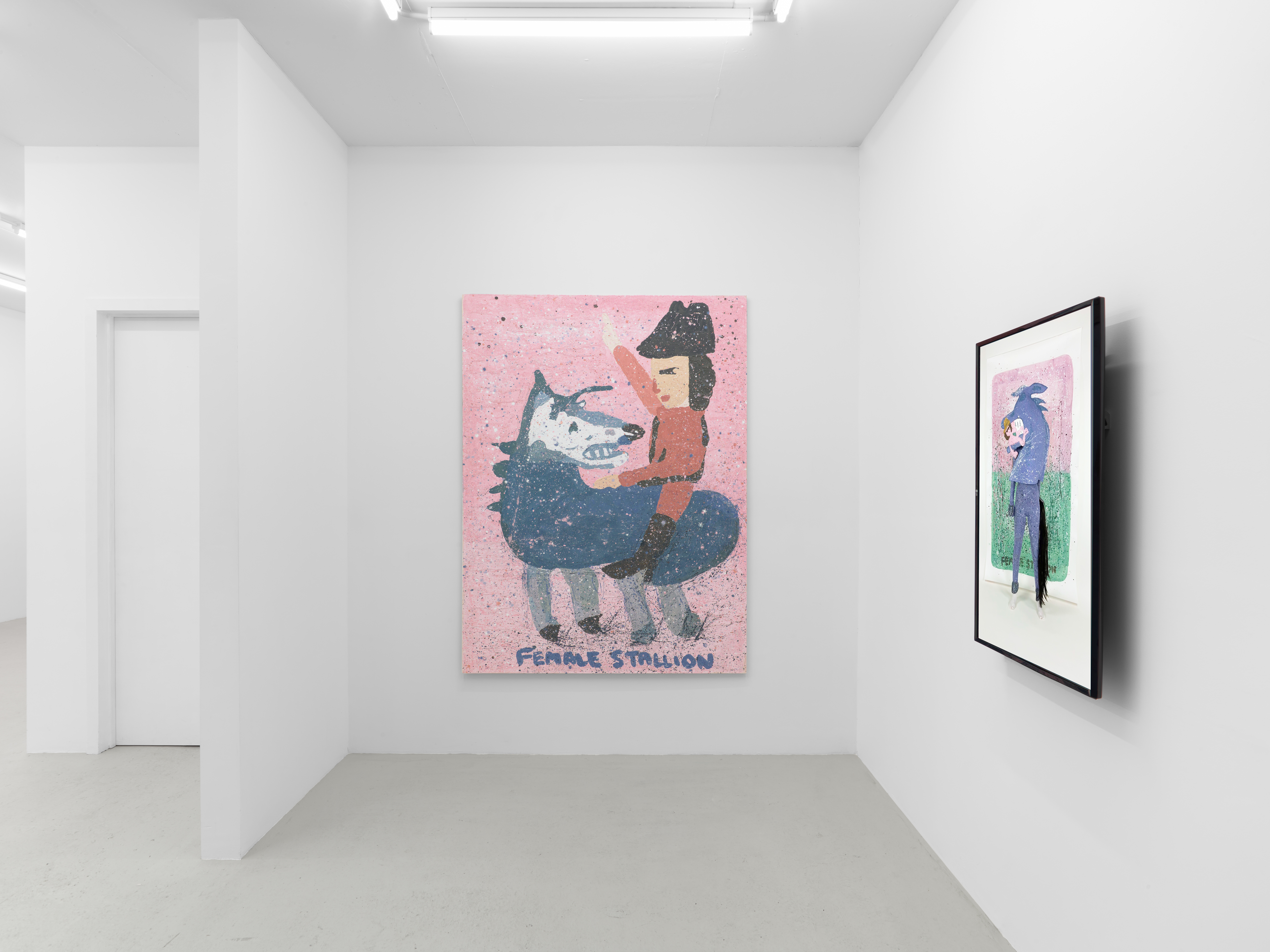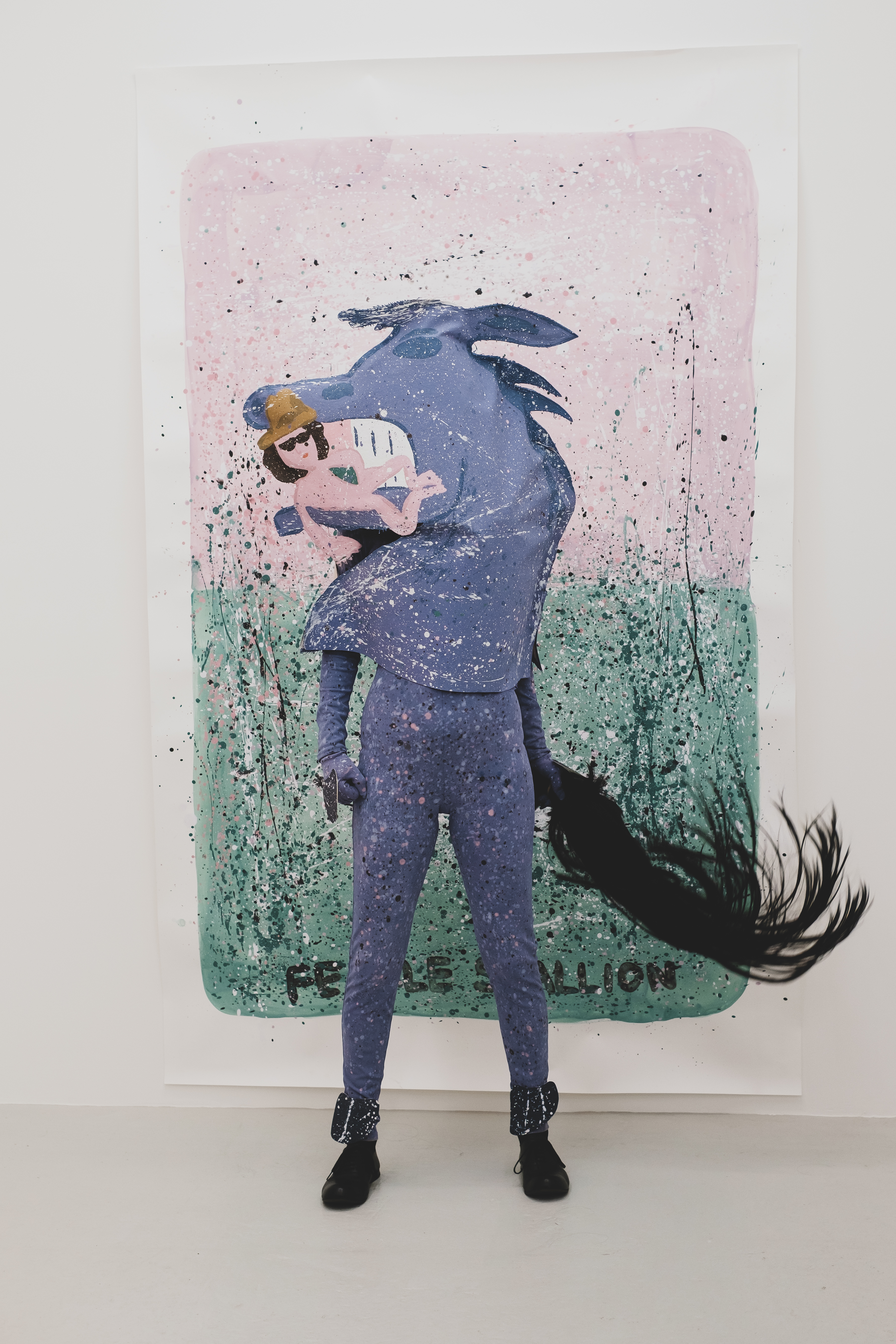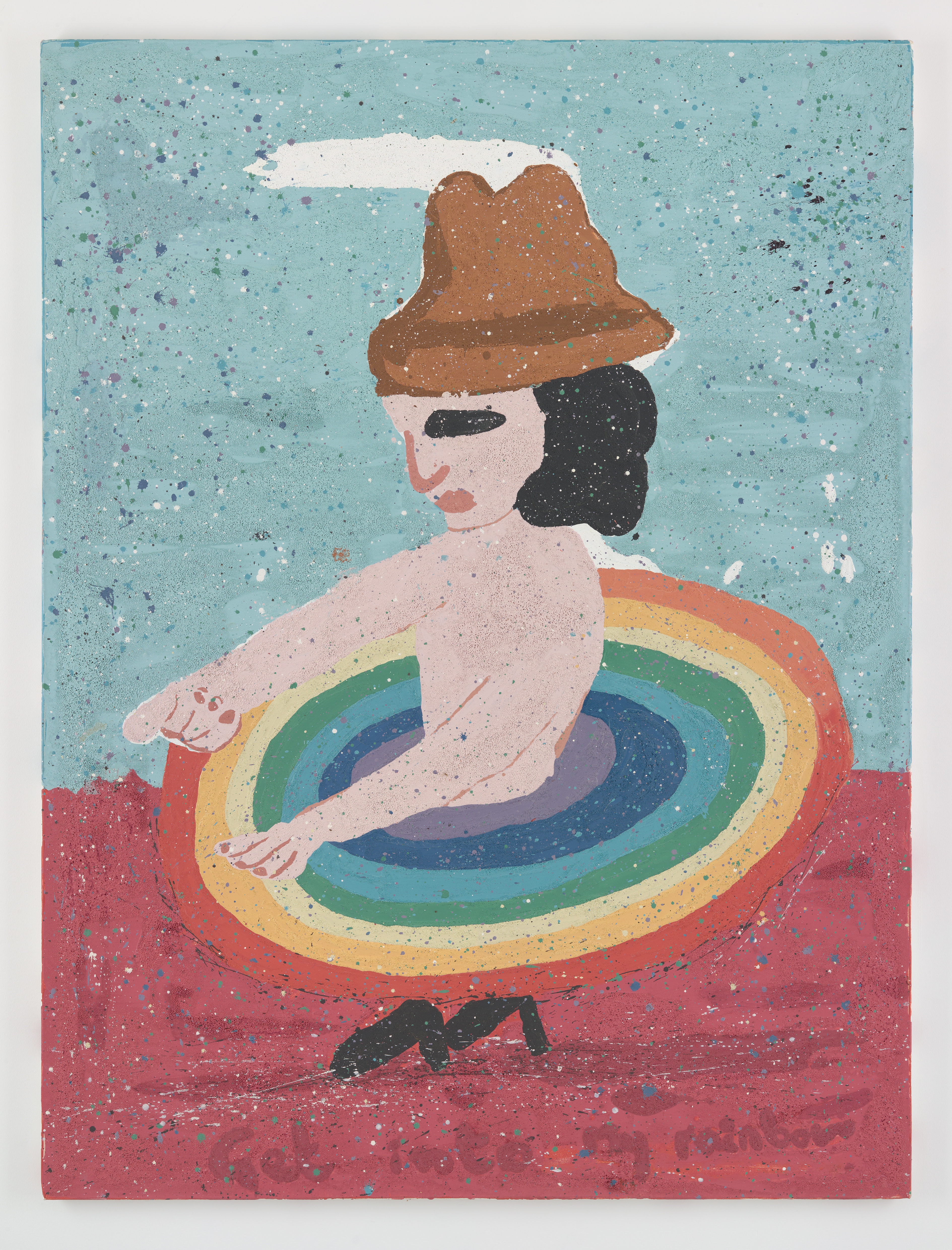KATE GROOBEY
Something close to the reality of love, an essay by Gabriella Pounds, 2022 "The mood is hyper." Kate Groobey explores the zone between ‘reality' and ‘fantasy': the overlap in the Venn diagram where Fact and Verification Needed coil. At 'Female Stallion' the artist has created fictional characters modelled on her (real) wife – the writer and poet Jina Khayyer – that recur throughout her paintings and films. Groobey lifts bits of language from her and Khayyer’s everyday conversations into her art. In Female Stallion, for example, pink and purple paint flecks simulate a fashion freak. She wears very cool sunglasses, an acorn-coloured fedora and poses in front of a blue horse. The artist further ironises the scene in her eponymous performance piece; reanimating the character with in-built iPhone camera settings such as Boomerang. Recordings of Khayyer’s voice rip through Groobey’s films and music like a gentle poltergeist. Khayyer’s interiority appears to be represented, reimagined and shared between human bodies; approximating something close to the reality of love. The ‘personal’ label – so often lackadaisically sucker-punched onto ‘women’s art history’ – is negated here. What a relief. Drawing on medieval Japanese Nō plays, Groobey involves her confessions of a mask, where the limited visibility of the theatre accessory seeks to direct the performer and audience inward, aiding access to the inner galaxy of a character. In concert with the presiding philosophy of medieval Japan, Nō performers, characters and audiences were encouraged to empathically become one mind in many people. Groobey’s characters are unconcerned with symmetry or proportion. Their eyes are wide, limbs stumpy, noses button. They recall cute villagers from the Japanese video game Animal Crossing (2001). Get into my Rainbow depicts a smol figure submerged in a swirl of colour. The mood is hyper. And the artist seeks to inspire feelings of excitement. Groobey’s paintings point towards a futurity of existential autonomy without the heaviness of the 'I'. Baby pink, [aqua] green and a spill of [white] oils comprise Be in Bloom. Spears of wild flowers grow from the protagonist’s hair. And underscore the psychedelic ontologies latent in the natural world. Groobey’s compositions and headless drips of paint, meanwhile, evoke the German painter George Baselitz’s remix paintings, which in turn were a repurposing of Jackson Pollock’s abstractions into anti-heroic narratives. Evocative of cum shots, the artist reworks Baselitz’s failed hyper-masculinities into her own feminist art history. Looking at Goobey’s paintings, I am reminded of another Austrian doomer who expunged the ego shit in his – successful – anti–quest for the literary Universal. ‘I avoid [art] whenever possible, because whenever possible I avoid myself,’ the novelist Thomas Bernhard once wrote. Amen brother. Gabriella Pounds is a writer and critic from Brighton.
POWERFUL BODIES essay by Max Kaario, PLATFORM, David Zwirner with Sean Horton, 2022. "women can be as strong or stronger than men." The figurative representation of human bodies in Western painting has often offered narratives of ideal beauty or gestural postures that portray civilized demeanor rather than somatic experience. Women especially have been endemically portrayed as an ideal of beauty and almost always through the gaze of a male painter. Since the mid-20th century, artists have been questioning ideals of bodily beauty as a tool of subjugation. Indeed, much contemporary art practice includes a celebration of the body in all its forms. This was perhaps most poignantly initiated by the experimental performance art of the 1960s. For example, Carolee Schneeman and the collectivity around Judson Dance Church radically recalibrated expectations of what is representative of human movement, action, and form. In contemporary painting, this resistant vigilance is maintained through a questioning of standardized versions of storytelling, behavior and physical beauty. Contemporary painting recalibrates the expectations of painterly skill, sometimes crudely rendering human figures, inverting gender norms, representing impossible bodily postures, a reassertion of the image as capable of invoking ecstatic relief from the digital algorithms governing contemporary society. In Kate Groobey’s Female Stallion, the title is written horizontally at the bottom of the canvas, a semiotic anchorage which frames the painting through a humorous lens that upsets gender norms and transmits a sense of power. An ambiguously female human figure is posed in the mouth of a barely recognizable horse. There is a juxtaposition between the human and equine bodies, the establishment of a metaphor about strength and resistance. The work blows expectations of painterly skill out the window, exhibiting crude technique, allowing the image to function almost as a pictogram, clear in its message: women can be as strong or stronger than men.
Apple and Hat, review by Rebecca Geldard of 'Get into my Rainbow', as seen in NADA Curated 'Like a child' by Daonne Huff, 2022. "It's hard not to love the art of Kate Groobey, which makes it a curious thing to think about before beginning to assess why that is. Its gloriousness lies in the simplicity of her approach - but of course elaborately manufactured in ways that hide a heap of complexities. Harnessing the power of perhaps the worst of performance art conceits she creates living moments of the human subject as already depicted, in the round. The joys, problematics and multidimensional ideas around what it means to represent a thought, act or moment are combined and revealed through a ridiculous lens alive to the question of why we exist at all. In the venn mix of this we are freed from the specifics of all processes in play to consider that rare thing in the days of perpetual recording - the elusive state of actual presence "
Sim Smith is proud to present Female Stallion, Kate Groobey's second solo exhibition at the gallery. The exhibition develops across large oil paintings, accompanying performances and film. The protagonist of these works, Groobey's wife, the writer and poet Jina Khayyer, is not only the beating heart of this show but its stimulation across Groobey's rich and abundant practice. It is a show that explores what it means to be a Female Stallion in today's world. There are six large oil paintings in Groobey's new painting series Female Stallion with accompanying performances that see the paintings brought to life by Groobey herself, who dresses up as her characters in painted costumes, performing improvised dances in front of painted backdrops to music of her own creation. Speaking the language of social media to draw us in and immerse us in her world, Groobey has created a video- series made on her iPhone, incorporating a series of movements developed with BOOMERANG
Studio International, interview by Anna McNay, 2022 ‘The drip, for me, is pure joy and a kind of thrill’. Kate Groobey (b1979, Leeds) combines painting and performance to break down barriers between her audience, her protagonist and herself as performer. For her latest series, Female Stallion, which comprises six large canvases with their associated soundtracks and performances, her muse is her wife, the writer and poet Jina Khayyer, and her purpose is to create a safe, feminine and queer space, which might ideally make people feel inspired, stronger and more empowered...
Plinth, 'Horsing Around', an essay by Eloise Hendy, 2022. "a zany, campy fairytale" In a way, all artists are clowns. Not in the sense of being comic performers — ‘characterised,’ as International Clown Hall of Fame puts it, ‘by coloured wigs, makeup, outlandish costumes and usually oversized shoes’ — but in the more ancient sense of defying convention, mocking authority, and causing disruption. Of being tricksters; subversive truth tellers. The artist and the clown inhabit two worlds at once: the ‘real world’ of the everyday, and the land of the imagination, which is populated by symbols, archetypes and fantasy. Taken to their illogical conclusions, artistry and clownery resemble magic — rattling reality through a series of tricks. Kate Groobey’s art is the work of clownery par excellence. In her new solo exhibition Female Stallion, everyday moments become extraordinary flights of fantasy...















































